History of Power House Rowing Club

Chapter 4. A personal recollection by Max O’Brien
Part 1- The early days
Our wonderful Rowing Club had been resurrected in the late 1950s. We had to struggle to maintain what was left of our fleet from earlier days. We understood that our club had been created in 1932, and that it had been formed to help the Lord Somers Camp organization obtain the lease on their site at Albert Park Lake. The Camp Chiefs did their best to foster the development of the Club during the 1930s, when it competed regularly up to the start of World War 2, and after 1948 when rowing activity was restarted. However the Club had difficulty in attracting enough oarsmen to be able to compete regularly.
In 1957, there was a single bay for boat storage on the North side of the old Power House building. This contained one new plywood racing eight and a number of vintage boats, of clinker construction. One even had poppet riggers.
I recall the race for a Beginners Four at Edwardes Lake, Preston. At this time, while we were a very small group, all the members were having a good time and were totally dedicated to the Club and to the sport of rowing.
On this particular day I think we won our event and with the boat sinking under us we managed to get back to the staging. Then the fun began! The boat was so heavily water logged that we couldn’t lift it out of the water. Our cries for help were responded to by our competitors who rushed to our aid. With their assistance we lifted the water filled boat out of the water and rested it on our knees.
With all the support around our stroke, Jim Petty, took charge and called for the hull to be lifted, tilted to remove some of the water, and then a toss of the hull. This was followed with a huge roar of laughter as seats, slides and the odd stretcher, together with sundry other pieces, fell to the staging. Just the sort of display that made our day.
During this time, rowing conditions on the Lake were reasonable, but were never as good for training as the Yarra. We were often moving boats between the two places. In the early days, the members used a handcart which was owned by the Albert Park Rowing Club. This could take an Eight, but pushing it down the middle of St. Kilda Road in Saturday evening traffic is an experience to be remembered. Particularly memorable was one occasion in which those at the front found on reaching Lorne Street that those at the back had dropped off at the Chevron Hotel while passing!
To go to Regattas in the country, we hitched a ride for our boats with other clubs, either on a truck or on the roof of a bus, which then carried all the rowers as well.
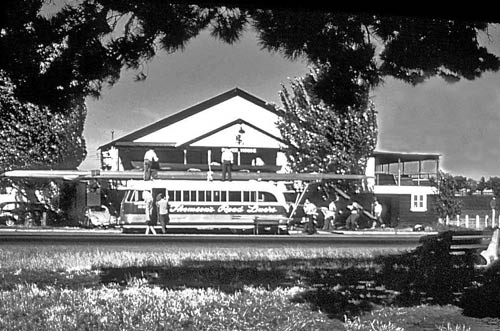
Loading boats for Yea Regatta, 1959
The Club’s first step in developing low cost transport facilities was a roof rack that was made to fit a Holden station wagon, and was lifted into place and bolted on to the bumper over-riders. It was very cost efficient in transporting pairs and fours to any of our regattas at minimal cost. This proved very successful and was copied by some other clubs.
In those days it was all we needed, as the club was still quite small. However this was soon to change when we decided to develop a means to transport eights. We were the first club in Victoria, and possibly Australia, to build and use a trailer capable of transporting two racing eights or other sizes, with the prime mover being a standard Holden station wagon.
Utilizing information obtained from the responsible state government departments we arranged with Rice Trailers of Highett to construct a trailer that complied with all government standards. It was necessary to keep the length of the trailer within the maximum permitted. This was achieved by elevating the end of the trailer closest to the Holden and cantilevering the trailer over the roof of the prime mover thus creating compliance in length.
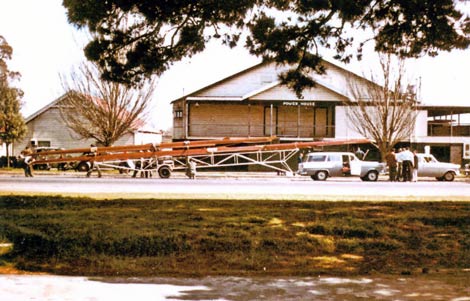
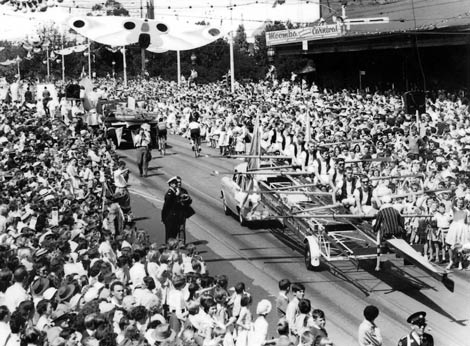
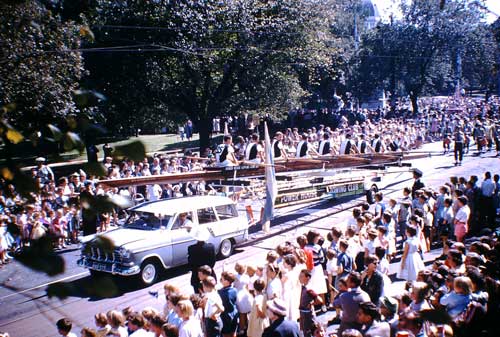
The trailer created a lot of interest, particularly one year when the Club entered a fully crewed Eight in the Moomba Procession, the first racing eight to go over Princes Bridge.
Time went by and the club progressed slowly but surely, as we recruited more members and money came in from the Sunday Night Dance, allowing us to purchase better boats and equipment. LSC&PH rebuilt the McAdam House and we were able to expand our storage area, and for a time, to house two schools, Brighton Grammar and then Caulfield Grammar, who were starting Rowing as a sport.
But from the mid 1960s, rowing conditions on the Lake deteriorated dramatically. There was always a problem with the vertical concrete walls which worsened the effect of waves and caused very rough rowing conditions. Boats were sometimes swamped at the neck near McAdam House. Fortunately the lake was so shallow that boats could be walked back to the Clubhouse. A much more important problem was that the Lake could not accommodate a course meeting the traditional requirements for senior rowing of 1 mile, and this problem still exists.
Then the weed problem surfaced. This seems to have been resolved in recent years, but during the sixties it created many problems for all users of the Lake. The Albert Park Lake Advisory Committee was very active in continuously dealing with all aspects of the infestation of the Lake.
One of the proposals was to introduce Chinese Carp, but the Fisheries and Wildlife Department at that time were unable to distinguish this species from the European Carp, and so vetoed this approach.
A more exotic proposal was to import manatees from South America and release them in the Lake. The manatee is a large aquatic mammal that feeds on weeds and is used in Africa and South America to keep channels clear. This proposal almost reached submission stage before someone asked what would happen if a racing shell or a speedboat hit a half–ton animal.
The remaining solutions revolved around dumping more chemicals in the water and mowing the weeds. This latter cure was worse than the problem, as the weeds were changed from a vertical fixed to a horizontal floating position. The loose weeds would wrap themselves around an oar, bringing both the oar and the oarsman to a sudden halt. Rowers became adept at flicking the oar out of the water, spinning it to remove the weeds and resuming the stroke.
During the difficulties of these weed years prior to 1970, we were able to make use of the hospitality of the Melbourne Rowing Club who were magnificent hosts under the guidance of Harry Yoffa, a highly respected veteran oarsman who was constantly supportive, although storage was limited.
Terry Goss, our President, successfully negotiated with the Melbourne City Council for use of the strip of vacant land between the Melbourne Rowing Club and Richmond Rowing Club. This would enable us to store our required boats on the river during the competitive season from January to April 1969, whilst making use of the facilities of Melbourne and Richmond Clubs. However the MCC’s letter granting approval stated that this was the last time that this would be allowed.
Part 2 - The Power House Sunday Night Dance
The story of the Sunday Night Dance is covered elsewhere in our history. In 1958, the Club had little money, not many members and a tiny fleet. Our problem was the lack of funding to enable the club to develop further.
There did not seem to be any opportunity to overcome these difficulties until, one night, a number of our members were at the 431 dance in St Kilda Road, which had a very popular “casual” format. The Management informed the crowd that they would be closing down in the next few weeks.
We decided that the Rowing Club should start its own dance, and six members approached the Council of Lord Somers Camp & Power House for their approval and support. The Camp Chief at the time was Colonel Phillip Rhoden who was also a leading solicitor in the city of Melbourne. We were fortunate indeed to have such an outstanding group of members of the Council under such fine leadership.
There were some concerns expressed as to whether a dance on Sunday night was appropriate for LSC&PH, but a prior discussion with the Chaplain of the organization resolved this point. Every detail was considered and resolved in an atmosphere of mutual co-operation, and we were able to take the first step of what became one of the most successful Club activities ever. The Rowing Club undertook to pay, after the first 12 months, half of the proceeds to LSC&PH to help fund their activities.
The following week Ken Dowdney and I and other members were out in St Kilda Road putting posters under car wipers telling the people at 431 that the Rowing Club would be running a dance on Sunday nights at Power House on Albert Park Lake.
The Dance proved very successful, and continued for a number of years, due to the entrepreneurial approach adopted by those members who took charge of running it. We also gained many recruits, which helped to boost our performance on the water.
Ultimately, due to their efforts, the club was able to pay, from its own resources, approximately $80,000 to construct the Boat House, including the first indoor rowing pool in the world, on time and within budget. Also included was our new staging, which had not been part of our original estimates.
Part 3 - Our New Boat Shed
By 1967, our frustrations about rowing conditions on the Albert Park Lake had reached the point that a move to the Yarra became imperative.
Our first thought was to locate our new premises next to the Richmond Rowing Club. We would be in the centre of Rowing, we would be able to use the staging, and we would be the closest club to Princes Bridge. With this in view we commenced discussions with the Melbourne City Council. After some time we only had two major issues to resolve with them before proceeding.
The first issue was that we wanted to lease from the council a select piece of public land. We were told that we would have to establish the level of use by the public, to ensure that there would not be undue disadvantage to them.
Some members and wives working in the city undertook to carry out a site inspection on a daily basis. They had to make a written report documenting the number of persons accessing the site and the use of the site for any functions. This activity continued for approximately twelve months and was a wonderful effort by those participating.
The second requirement was that we would have to obtain the consent of the Victorian Rowing Association. Our confidence was high as the report of site usage was highly in our favor.
The Victorian Rowing Association called for a meeting at the premises of the Amateur Sports Club in KcKillop Street, then located between Bourke & Collins Street. We were on familiar ground as many of our members attending also belonged to the Amateur Sports Club.
Most Rowing clubs in Victoria were represented and all would be required to vote. However, many of the country Rowing Clubs made a practice of appointing proxy delegates from one particular city Rowing Club, so that their official delegates did not have to travel to Melbourne for VRA meetings. Our representatives made their presentation and on completion the delegates were invited to submit any questions. The vote was then taken and we lost, by a margin of one vote.
Following this meeting further submissions were made to the Melbourne City Council without success. We were all most disappointed at this result. We had spent years getting to this stage and we had failed. All our members were disgruntled to say the least. The loyalty and determination of our members was what you would expect from our Rowing Club. Within a few days our members were ready to find another site.
Do you remember the stroke of the Beginners Four? He was Jim Petty, son of Sir Horace Petty who had been a Mayor of Prahran City Council. Jim could claim to have had great training in his youth and he led the charge with tenacity and success.
The most suitable site for a Rowing Club away from Princes Bridge was adjacent to the Wesley Rowing facility in Alexandra Avenue at the end of Williams Road. It transpired that the Prahran Council had a plan which allowed for four boatsheds in this area.
Approaches were made to the Council, and you can imagine the excitement of the members when the Mayor at the time, Cr, Chris Gahan, advised that they would issue a lease for a twenty-year period.
A special committee was formed to construct our new premises and the first meeting was held on Thursday 29th May 1969 at 541 St Kilda Road. The minutes list those present were Max O’Brien (Chairman), Bruce Manning (Secretary), David Seator and Graeme Smith. Two members, Ken Dowdney and Terry Goss were unfortunately unable to attend due to short notice.
The minutes report that excavation work had been authorized to proceed on the 28th May 1969 and included a number of other issues to be resolved. My Diary notes indicate that on-site works were to commence on the newly leased site on the 29th October 1969.
Within a very short time, the heavy earth moving equipment was moved on site, and work commenced to excavate the area in accordance with the area specified on our lease on the North side of the Wesley Boat Shed.
Then the drama started! Before lunch the Head Master and Bursar of Wesley arrived on
site and informed our contractors that work must cease forthwith and that we were trespassing on the area
leased to Wesley. Numerous telephone conversations followed. Having regard to our previous difficulties, we took the position
that we would continue with the excavation work. We based this on the following relevant issues.
(a) Having commenced excavation, considerable work would have to be done at our cost to reinstate the site.
(b) We would utilize every right we had under our lease.
(c) We should appoint a group to negotiate with the Council and Wesley, under the leadership of an old
Wesley boy and former captain of our Club, David Seator.
There was a prompt resolution of the problem. A meeting was held at the Council Offices that evening, followed by another the next morning at the site, when David met representatives from the Council and Wesley. The City Engineer soon realized that the plan of the area, upon which Wesley’s lease was based, was flawed because the high water mark was not properly delineated.
After reviewing the whole area, our Club was granted the lease on the adjacent parcel of land where the building now stands. There were some conditions. We had to complete the excavation to enable Wesley to make immediate use of the area, at our cost. We also had to consider provision of water, sewerage and availability of suitable staging on the new site.
This was such wonderful news for us all, although it would involve redesigning the building, investigating the construction issues already listed, and complying with the restrictions of the proximity of the power lines.
This was all to happen in the future, but we would get our shed. It was also good that we were able to resolve our differences with Wesley amicably, thus fostering good neighbor relations.
This Building Committee went on to discharge its responsibilities efficiently, thus enabling the club to be formally opened on the 14th February 1970, when we were able to entertain official visitors from the Prahran City Council, Lord Somers Camp and Power House, the Victorian Rowing Association and other Rowing Clubs as well as members and partners. That night, we held the first disco in the Club’s new home.
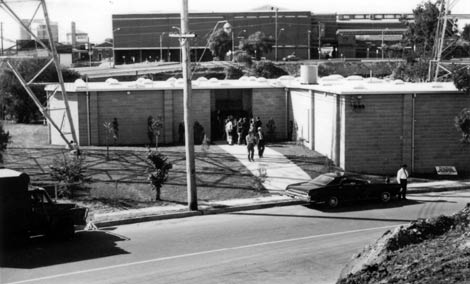
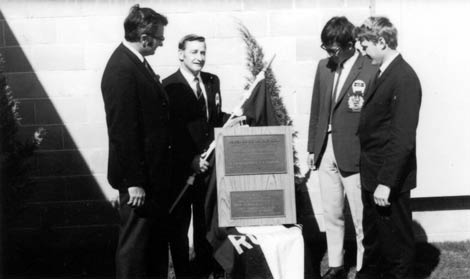
M O’Brien, W King, T Goss, Cr. C Gahan
All the members of the Club, starting from the year of 1957 to the present day, could not have achieved this result without magnificent club loyalty and dedication from all members.
Remember the wonderful words of the Somers song.
“No matter how much the ghastly pain
So long as the finishing post we gain.”
Part 4 - Anecdotal stories
We were getting close to completion and money was short, when Wesley came once again to our support. They agreed to permit us to use their sewer tank system for the newly located premises. This generous act enabled us to complete our sewer installation at a greatly reduced cost. The only memorial of this assistance is visible to every male using the Clubhouse. The step to the male urinal is at a slightly higher level than usual. Males must watch their feet.
The concrete footings caused a stir on the day we commenced footing excavations. We were extremely fortunate in having two highly experienced concreters on site who telephoned me after they had started the excavation requesting me to come to the site at once. They had discovered that on removal of the surface soil, the rock was in much larger sections than we had expected. On arrival on site I agreed to their recommendations that the explosive charges should be reduced by approximately 75% where necessary and accepted the fact that additional charges would apply. Our main concern was that if the rock should be part of a reef it may cause some stress to the Wesley Boat House and that of course would be the last thing we would wish to do.
As mentioned already, we had expected to be able to use the existing staging, and now had to provide our own. We were extremely fortunate that Graeme Smith, a very dedicated member of the Club, and of the Building Committee, and who had also been responsible for much of the success of the Sunday Night Dance, was also a timber merchant and he selected and supplied the timber decking which has proved to be an outstanding maintenance free material.
Adjustable Steel Boat racks were provided to ensure that we could support any modern boat hulls that we may acquire in the future and for an improved fire prevention program. The racks are structured in such a way that electric lifts could be used to lift larger boats into the upper racks quickly and safely, should there be the need and available funds in the future.
There was a report in either the Melbourne Herald or the Age that ours was the first indoor rowing pool in the world. This pool was based on an outdoor pool built by Graham Fudge at Wesley College, Glen Waverley. Graham was a Wesley Old Boy and still is a great friend of mine, with both of us having been active together in the Master Builders Association of Victoria for many years.
